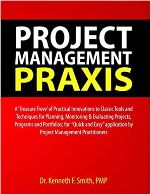BOOK REVIEW
 Book Title: Project Management PRAXIS
Book Title: Project Management PRAXIS
Author: Dr. Kenneth F. Smith, PMP
Publisher: Central Books Supply, INC.
List Price: $ 65.00
Format: Paperback, 358 pages
Publication Date: 2018
ISBN: 9781722460082
Reviewer: Swati Shah
Review Date: February 2020
Introduction
This book is a compilation of “Best Practices” for planning, monitoring, managing and evaluation of projects and programs (to some extent portfolios as well). It provides an in-depth overview of the Classical Project Management tools and techniques available during the early 20th as well as the current era of Project Management.
The author, Dr. Smith, has diverse experience as an analyst & system specialist with the US Department of Defense, Senior Foreign Service Officer with the U.S. Agency for International Development (USAID), and through his involvement as an itinerant project consultant with the international development donor community – including the World Bank, African Development Bank, the United Nations, and the Asian Development Bank. Every chapter of the book reflects the plethora of knowledge Dr. Smith has gained throughout his career as a long-time member of the Project Management Institute (PMI); a practitioner, researcher-evaluator, manager, advisor, consultant, and instructor/facilitator in project management. He has developed the Project Management ‘Tool Kit’ as an aid to make project management decisions and to evaluate project performance. This toolkit available to purchase separately.
Overview of Book’s Structure:
The book consists of 10 chapters with 358 pages. The book is a recapitulation of the author’s “Treasure Trove” – his perspectives and his created and/or adapted Project Management Tools and Techniques.
Chapter-by-Chapter Review
Chapter 1 primarily covers historical journey of the Critical Path Method and the several related tools and techniques for planning, scheduling, monitoring, and evaluation. During the early 20th century, these tools and practices were used first by (or for) the U.S. Military, then subsequently honed for broader use. The top three are: Work Breakdown Structure (WBS), Gantt/Bar with Milestones Charts, and Critical Path Method. It is intriguing to see the growth from manual data computation, Plan-a-log kit in a suitcase, typewriters, Spirit and Ink copiers, IBM 7090, Fortran 4, Primavera, to MS Project. This chapter gives you an appreciation for the fact that Project Management has been around for a while and has progressed over time!
Chapter 2 provides an overview of the EVM (Earned Value Management) with detailed discussion of Primary “Driver” indicators, “Derivative Indices”, “Derivative Values” and “Derivative Percentages” indicators. The author highlights some unique limitations of the monitoring and measuring project performance.
Chapter 3 focuses on projects containing repetitive or iterative processes. The Line of Balance (consists of Production flow plan, an objective chart, and a Progress Status Chart) can plan and monitor such projects more efficiently, economically, and effectively.
More…
To read entire Book Review, click here
About the Reviewer

Swati Shah
Irving, Texas, USA
![]()
Swati Shah currently works as a Project Coordinator at a manufacturing company based in Irving, Texas, USA. She was previously an Elementary School Teacher. Swati secured her CAPM and CSM certificates and has applied her teaching skills as well as ongoing project management experience to successfully transition to, and be successful in, the field of Project Management. She aspires to secure her PMP certification in the near future.
Editor’s note: This book review was the result of a partnership between the PM World Journal and the PMI Dallas Chapter. Authors and publishers provide books to the PM World Journal; books are delivered to the PMI Dallas Chapter, where they are offered free to PMI members to review who agree to provide a review within 45 days; book reviews are published in the PM World Journal and PM World Library.
If you have read a good recently-published book related to managing programs, projects or teams of professionals, consider authoring a book review for publication in the PM World Journal. For our standard format or for more information, contact Editor@pmworldjournal.com or visit https://pmworldlibrary.net/book-review-program/
If you are an author or publisher of a project management-related book, and would like the book reviewed through this program, please contact Editor@pmworldjournal.com.









